Comics in the Art Room with guest blogger Sunnylee!
Hey folks! Guest blogger and School District of Philadelphia Art Teacher, Sunnylee Mowery here! Last month, thanks to the generous support of The Kennedy Center’s VSA (Very Special Artists) Division, I got to lead a workshop on using comics in the art classroom at Moore College of Art & Design’s “Art Education for Special Populations Symposium.” The 2016 symposium was organized around idea of “narrative” so I decided to design a workshop that explored the hip, new trend of teachers using comics as a means to document, digest, and reflect upon their day-to-day adventures in the classroom. Comics, themselves can be a great way to help your younger artists spark dialogue or to engage with complex information. Having a bunch of black “comic starters” available in your classroom is a wonderful way to help you find out more about your students’ personal narrative or interior motivations 9 (Student “Day in the Life” comic pictured below).
If you’re new to comics and not sure where to begin, one super easy way to bring comics into your art room is to create a small comics library that students can explore a variety comic formats and styles. Personally, I started small a few years ago with a collection of five, and I try to add one or two books to the collection each year. Below are my top ten picks of kid-friendly comics!
- “Drama” by Raina Telgemeier
- “American Born Chinese” by Gene Luen Yang
- “Persepolis” by Marhane Satrapi
- “Ms. Marvel Volume 1: No Normal” by G. Willow Wilson
- “Anya’s Ghost” by Vera Brosgol
- “Miles Morales: Ultimate Spider-Man Collection Book 1” by Brian Michael Bendis and Sara Pichelli
- “Smile” by Raina Telgemeier
- “The Odyssey: A Graphic Novel by Gareth Hinds
- “A Wrinkle in Time: The Graphic Novel” Adapted and Illustrated by Hope Larson
- “The Legend of Bold Riley: Warp and Weft” by Leia Weathington & Zack Giallongo
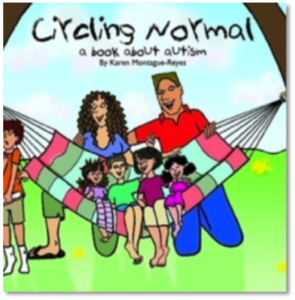 The workshop also touched on how comics can be a really effective way to create an inclusive classroom. There are a growing number of authors and illustrators who identify with special needs who are using comics as a way to convey their unique experience. There are several great titles, such as “The Ride Together” by Paul & Judy Karasik or “Circling Normal” by Karen Montague-Reyes, that are penned by authors who are on the Autistic Spectrum. Or “Epileptic” by David B., a just published graphic memoir about two brothers journey of growing up together and dealing with the life-altering symptoms of Epilepsy.
The workshop also touched on how comics can be a really effective way to create an inclusive classroom. There are a growing number of authors and illustrators who identify with special needs who are using comics as a way to convey their unique experience. There are several great titles, such as “The Ride Together” by Paul & Judy Karasik or “Circling Normal” by Karen Montague-Reyes, that are penned by authors who are on the Autistic Spectrum. Or “Epileptic” by David B., a just published graphic memoir about two brothers journey of growing up together and dealing with the life-altering symptoms of Epilepsy.
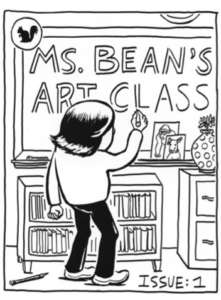 The second part of my workshop highlighted the work of art teachers producing original comics about their classrooms. Let’s face it, people, our art rooms are exciting places were innovation, ingenuity, hilarity, epiphany transpire each day! If this genre sounds interesting to you, I highly recommend checking out Ms. Bean’s Art Class, created by Massachusetts-based high school art teacher, Cara Bean. Her work is so beautifully done and she absolutely nails the art teacher experience with humor and grace! I would also be remised, if I did not give a shout out to the web-based comic, Supertizer!, created by Philly’s own Peter Coyle. His work is edgy, real, gut-busting and has inspired me to get my pencil out and make a comic for myself each week!
The second part of my workshop highlighted the work of art teachers producing original comics about their classrooms. Let’s face it, people, our art rooms are exciting places were innovation, ingenuity, hilarity, epiphany transpire each day! If this genre sounds interesting to you, I highly recommend checking out Ms. Bean’s Art Class, created by Massachusetts-based high school art teacher, Cara Bean. Her work is so beautifully done and she absolutely nails the art teacher experience with humor and grace! I would also be remised, if I did not give a shout out to the web-based comic, Supertizer!, created by Philly’s own Peter Coyle. His work is edgy, real, gut-busting and has inspired me to get my pencil out and make a comic for myself each week!
During the final part of my workshop, participants set to work designing their own “jam comic.” A jam comic is a comic created by more than one artist. Participants were asked to write down their greatest fear as a first year teacher on the top of the paper. The next step was to pass the paper to someone else at their table, who was charged with the task of illustrating this fear in comic form, and for extra points, resolving the conflict in a creative way. I got this idea from a blog post created by Jarod Rosello, a PhD student in curriculum and instruction at Pennsylvania State University.
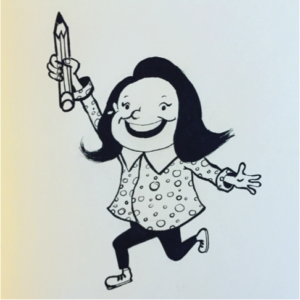 It was interesting to see such universality in the fears that were documented. Several participants confessed fears of the class running wild and becoming unmanageable, many of the comics focused on a fear of one’s “teacher voice” not commanding attention or betraying internal fears. Other teacher comics sited awkward observations, forgotten lesson plans, and even accidental risqué art exposure! If you’re an art teacher looking for a way to distress and laugh at yourself in good fun, pick up your micron and share the story of your classroom! You know it’s way too goo to just keep to yourself. 😉
It was interesting to see such universality in the fears that were documented. Several participants confessed fears of the class running wild and becoming unmanageable, many of the comics focused on a fear of one’s “teacher voice” not commanding attention or betraying internal fears. Other teacher comics sited awkward observations, forgotten lesson plans, and even accidental risqué art exposure! If you’re an art teacher looking for a way to distress and laugh at yourself in good fun, pick up your micron and share the story of your classroom! You know it’s way too goo to just keep to yourself. 😉
Signing off,
Sunnylee Mowery

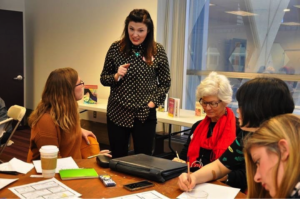
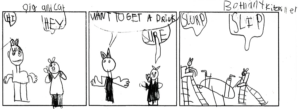
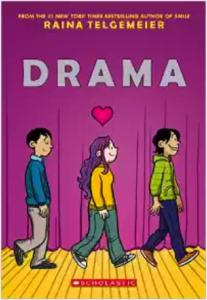
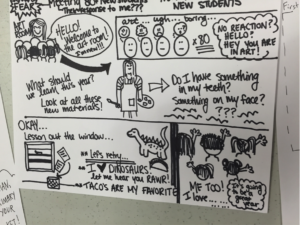
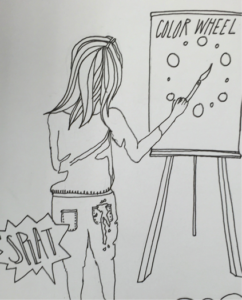
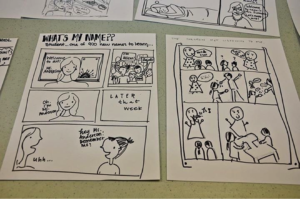
 D5 Creation
D5 Creation